Difference between revisions of "Huai-kan"
| Line 2: | Line 2: | ||
<poem> | <poem> | ||
'''Huai-kan''' | '''Huai-kan''' | ||
| − | [懐感] (n.d.) (PY Huaigan; Jpn Ekan) | + | [懐感] (n.d.) (PY Huaigan; Jpn [[Ekan]]) |
| − | Huai-kan (Jp. Ekan) [7th-8th cent.] | + | Huai-kan (Jp. [[Ekan]]) [7th-8th cent.] |
| − | Huai-kan was a disciple of Shan-tao who experienced samadhic visions of the Pure Land (nembutsu zammai) and wrote the influential Shih-ching-t'u-ch'un-i-lun (Jp. Shaku-jodo-gungi-ron). | + | Huai-kan was a [[disciple]] of [[Shan-tao]] who [[experienced]] samadhic visions of the [[Pure Land]] ([[nembutsu]] zammai) and wrote the influential Shih-ching-t'u-ch'un-i-lun (Jp. [[Shaku-jodo-gungi-ron]]). |
| − | A priest of the Pure Land school in China during the seventh century who lived at Ch'ien-fu-ssu temple in Ch'ang-an. He first studied the Dharma Characteristics (Fa-hsiang) doctrines and the Buddhist precepts, but, dissatisfied with these, he turned to the Pure Land teaching. Unable to believe that one could directly be reborn in the Pure Land by meditating on Amida Buddha, however, he sought out Shan-tao, the third patriarch of the Pure Land school, and confessed his doubts. Following Shan-tao's guidance, he meditated upon Amida Buddha for three years and is said to have realized the essence of the Pure Land teaching. He began writing The Treatise Resolving Numerous Doubts about the Pure Land Teachings, but died before he could finish it. Huai-yün, another disciple of Shan-tao, completed it. | + | A priest of the [[Pure Land]] school in [[China]] during the seventh century who lived at Ch'ien-fu-ssu [[temple]] in [[Ch'ang-an]]. He first studied the [[Dharma]] Characteristics ([[Fa-hsiang]]) [[doctrines]] and the [[Buddhist]] [[precepts]], but, dissatisfied with these, he turned to the [[Pure Land]] [[teaching]]. Unable to believe that one could directly be [[reborn]] in the [[Pure Land]] by [[meditating]] on [[Amida Buddha]], however, he sought out [[Shan-tao]], the third [[patriarch]] of the [[Pure Land]] school, and confessed his [[doubts]]. Following [[Shan-tao's]] guidance, he [[meditated]] upon [[Amida Buddha]] for three years and is said to have [[realized]] the [[essence]] of the [[Pure Land]] [[teaching]]. He began [[writing]] The [[Treatise Resolving Numerous Doubts about the Pure Land Teachings]], but [[died]] before he could finish it. Huai-yün, another [[disciple]] of [[Shan-tao]], completed it. |
</poem> | </poem> | ||
{{R}} | {{R}} | ||
Revision as of 16:16, 17 September 2013
Huai-kan
[懐感] (n.d.) (PY Huaigan; Jpn Ekan)
Huai-kan (Jp. Ekan) [7th-8th cent.]
Huai-kan was a disciple of Shan-tao who experienced samadhic visions of the Pure Land (nembutsu zammai) and wrote the influential Shih-ching-t'u-ch'un-i-lun (Jp. Shaku-jodo-gungi-ron).
A priest of the Pure Land school in China during the seventh century who lived at Ch'ien-fu-ssu temple in Ch'ang-an. He first studied the Dharma Characteristics (Fa-hsiang) doctrines and the Buddhist precepts, but, dissatisfied with these, he turned to the Pure Land teaching. Unable to believe that one could directly be reborn in the Pure Land by meditating on Amida Buddha, however, he sought out Shan-tao, the third patriarch of the Pure Land school, and confessed his doubts. Following Shan-tao's guidance, he meditated upon Amida Buddha for three years and is said to have realized the essence of the Pure Land teaching. He began writing The Treatise Resolving Numerous Doubts about the Pure Land Teachings, but died before he could finish it. Huai-yün, another disciple of Shan-tao, completed it.
